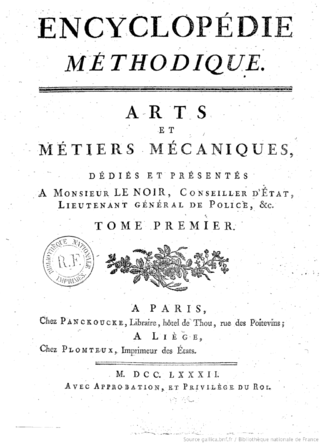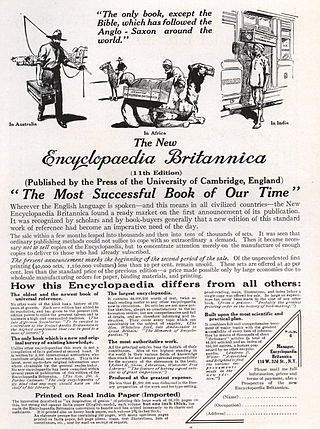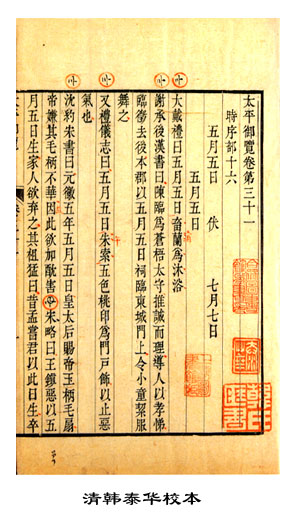
An encyclopedia or encyclopaedia is a reference work or compendium providing summaries of knowledge, either general or special, to a particular field or discipline. Encyclopedias are divided into articles or entries that are arranged alphabetically by article name or by thematic categories, or else are hyperlinked and searchable. Encyclopedia entries are longer and more detailed than those in most dictionaries. Generally speaking, encyclopedia articles focus on factual information concerning the subject named in the article's title; this is unlike dictionary entries, which focus on linguistic information about words, such as their etymology, meaning, pronunciation, use, and grammatical forms.

The Encyclopædia Britannica Eleventh Edition (1910–1911) is a 29-volume reference work, an edition of the Encyclopædia Britannica. It was developed during the encyclopaedia's transition from a British to an American publication. Some of its articles were written by the best-known scholars of the time. This edition of the encyclopaedia, containing 40,000 entries, has entered the public domain and is readily available on the Internet. Its use in modern scholarship and as a reliable source has been deemed problematic due to the outdated nature of some of its content. Modern scholars have deemed some articles as cultural artifacts of the 19th and early 20th centuries. Additionally, the 11th edition has retained considerable value as a time capsule of scientific and historical information, as well as scholarly attitudes of the era immediately preceding World War I.

Encyclopédie, ou dictionnaire raisonné des sciences, des arts et des métiers, better known as Encyclopédie, was a general encyclopedia published in France between 1751 and 1772, with later supplements, revised editions, and translations. It had many writers, known as the Encyclopédistes. It was edited by Denis Diderot and, until 1759, co-edited by Jean le Rond d'Alembert.
Henry George Bohn was a British publisher. He is principally remembered for the Bohn's Libraries which he inaugurated. These were begun in 1846, targeted the mass market, and comprised editions of standard works and translations, dealing with history, science, classics, theology and archaeology.

Cyclopædia: or, An Universal Dictionary of Arts and Sciences is an encyclopedia prepared by Ephraim Chambers and first published in 1728; six more editions appeared between 1728 and 1751 with a Supplement in 1753. The Cyclopædia was one of the first general encyclopedias to be produced in English.

Lexicon Technicum: or, An Universal English Dictionary of Arts and Sciences: Explaining not only the Terms of Art, but the Arts Themselves was in many respects the first alphabetical encyclopedia written in English, compiled by John Harris, with the first volume published in 1704 and the second in 1710. Although the emphasis of the Lexicon Technicum was on mathematical subjects, its contents go beyond what would be called science or technology today, in conformity with the broad eighteenth century understanding of the terms "arts" and "science," and it includes entries on the humanities and fine arts, notably on law, commerce, music, and heraldry. However, the Lexicon Technicum neglects theology, antiquity, biography, and poetry.

The Encyclopædia Metropolitana was an encyclopedic work published in London, from 1817 to 1845, by part publication. In all it came to quarto, 30 vols., having been issued in 59 parts.

Chambers's Encyclopaedia was founded in 1859 by William and Robert Chambers of Edinburgh and became one of the most important English language encyclopaedias of the 19th and 20th centuries, developing a reputation for accuracy and scholarliness that was reflected in other works produced by the Chambers publishing company. The encyclopaedia is no longer produced. A selection of illustrations and woodblocks used to produce the first two editions of the encyclopaedia can be seen on a digital resource hosted on the National Museums Scotland website.

The Encyclopédie méthodique par ordre des matières was published between 1782 and 1832 by the French publisher Charles Joseph Panckoucke, his son-in-law Henri Agasse, and the latter's wife, Thérèse-Charlotte Agasse. Arranged by disciplines, it was a revised and much expanded version, in roughly 210 to 216 volumes, of the alphabetically arranged Encyclopédie, edited by Denis Diderot and Jean le Rond d'Alembert. The full title was L'Encyclopédie méthodique ou par ordre de matières par une société de gens de lettres, de savants et d'artistes; précédée d'un vocabulaire universel, servant de table pour tout l'ouvrage, ornée des portraits de MM. Diderot et d'Alembert, premiers éditeurs de l'Encyclopédie.

Jeremiah Joyce (1763–1816) was an English Unitarian minister and writer. He achieved notoriety as one of the group of political activists arrested in May 1794.

The Encyclopædia Perthensis was a publishing project around the Morison Press in Perth, Scotland undertaken in the 1790s, with the involvement of James Morison. Morison went into partnership with Colin Mitchel and Co.

Rees's Cyclopædia, in full The Cyclopædia; or, Universal Dictionary of Arts, Sciences, and Literature was an important 19th-century British encyclopaedia edited by Rev. Abraham Rees (1743–1825), a Presbyterian minister and scholar who had edited previous editions of Chambers's Cyclopædia.

The Encyclopædia Britannica has been published continuously since 1768, appearing in fifteen official editions. Several editions have been amended with multi-volume "supplements", consisted of previous editions with added supplements or gone drastic re-organizations (15th). In recent years, digital versions of the Britannica have been developed, both online and on optical media. Since the early 1930s, the Britannica has developed several "spin-off" products to leverage its reputation as a reliable reference work and educational tool.

Dobson's Encyclopædia was the first encyclopedia issued in the newly independent United States of America, published by Thomas Dobson from 1789–1798. Encyclopædia was the full title of the work, with Dobson's name at the bottom of the title page.

Chinese encyclopedias comprise both Chinese language encyclopedias and foreign language ones about China or Chinese topics. There is a type of native Chinese reference work called leishu that is sometimes translated as "encyclopedia", but although these collections of quotations from classic texts are expansively "encyclopedic", a leishu is more accurately described as a "compendium" or "anthology". The long history of Chinese encyclopedias began with the Huanglanleishu and continues with online encyclopedias such as the Baike Encyclopedia.

Encyclopedias have progressed from the beginning of history in written form, through medieval and modern times in print, and most recently, displayed on computer and distributed via computer networks.
The Domestic Encyclopaedia; or, A dictionary of facts, and useful knowledge: comprehending a concise view of the latest discoveries, inventions, and improvements, chiefly applicable to rural and domestic economy is a small encyclopedia of the English language, in four volumes, published in London in 1802 by Murray and Highley, and compiled by Anthony Florian Madinger Willich. While most encyclopedias of the time, such as Encyclopædia Britannica, were printed in quarto, or in the case of Chambers Cyclopædia, even folio, the Domestic Encyclopedia was printed in octavo, 5 1/2 by 8+1⁄2 inches. There are roughly 500 pages per volume, and 28 plates in total. Volume 4 includes a 70-page supplement and a 33-page index. The subject matter of the encyclopedia centers around domestic and agricultural information, during a time when most people were farmers. Most of the plates show farm equipment.
Kendall's Pocket Encyclopedia was written by Edward Augustus Kendall and printed in London in 1802 by W. Peacock and Sons, with a second edition in 1811.
A Dictionary of Arts and Sciences was published in London in 1806–7. It was originally supposed to be edited by Dr. George Gregory, Prebendary of St. Paul's. However, Gregory was too involved in his clerical affairs, so most of the material was written by an anonymous hack writer, Jeremiah Joyce. As it would turn out, another encyclopedia meant to compete with the Dictionary, the British Encyclopedia, or Dictionary of Arts and Sciences which was supposedly edited by William Nicholson, was also written mostly by an anonymous hack writer, who turned out to be the same man.



















